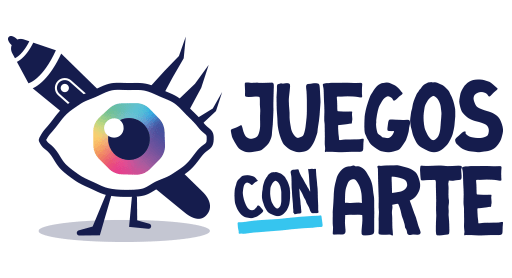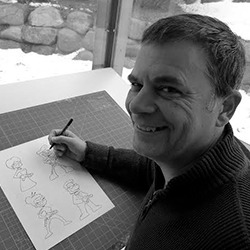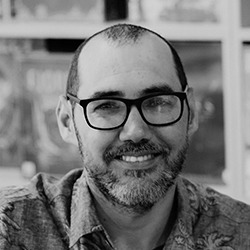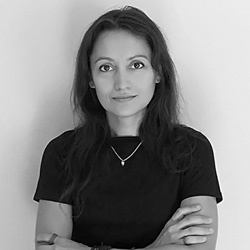
Tras disfrutar en cada partida el arte de la serie de juegos de mesa Tiny Epic, teníamos la obligación de entrevistar a Nikoletta Vaszi una de las responsables de su arte, para conocerla más y de paso que nos explicará como fue su creación y experiencia de trabajar para la editorial Gamelyn Games.
Os dejo que disfrutéis de su arte.
ENG | Welcome Nikoletta, for our readers who still don’t know your work, could you tell us a little about yourself and your beginnings in illustration?
Hi, thank you for having me. My name is Niki and I live in the UK with my husband.
My artistic journey started when I was around 10 years old. I loved animations and I wanted to be an animator. Drawing was also an escape mechanism I leaned on alongside with reading books and writing small stories. My Mum raised two kids alone, we never really had much disposable income so my access was very limited to education and material things. I grew up in Hungary and at that time an art career was not really a thing so no one really supported or took seriously my ambitions to become a professional artist.
I moved to England at age 18; I had to start to work and support myself financially. Art that time was only a hobby. What put me back on my artistic journey was a very bad and long sickness. I was pulling insane hours on regular bases for years as a waitress and that took a toll on my health, causing permanent damage. We sat down with my husband and decided I have to change my career. We reorganized our life, he bought my first Wacom tablet and I started to learn digital art. I was 25.
I tried to take the “official” route; I completed a foundation year in art and design in London, gained admission to university but there were issues granting the student loan. By the time they approved it I had lost my place and I already put plan B in motion. Plan B was I am gonna do this in my way and take a risk.
I had part time jobs while I was educating myself. I subscribed to Schoolism, got book books from the library, like Andrew Loomis and James Gurney. Three years in I have started to get commissions, small concept art jobs like creating characters. Nowadays I mostly work on card and board games, book covers. selling character designs and occasionally taking commissions.
ESP | Bienvenida Nikoletta, para nuestros lectores que aún no conocen tu trabajo, ¿podrías contarnos un poco sobre ti y tus inicios en la ilustración?
Hola, gracias por la invitación. Me llamo Niki y vivo en el Reino Unido con mi marido.
Mi trayectoria artística comenzó cuando tenía unos 10 años. Me encantaban las animaciones y quería ser animadora. Dibujar era también un mecanismo de escape en el que me apoyaba junto con la lectura de libros y la escritura de pequeñas historias. Mi madre crió sola a dos niños, nunca tuvimos muchos ingresos disponibles, así que mi acceso a la educación y a las cosas materiales era muy limitado. Crecí en Hungría y en aquella época la carrera artística no estaba muy extendida, así que nadie apoyó ni se tomó en serio mis ambiciones de convertirme en una artista profesional.
Me mudé a Inglaterra a los 18 años; tuve que empezar a trabajar y mantenerme económicamente. El arte en aquella época era sólo un hobby. Lo que me hizo retroceder en mi camino artístico fue una enfermedad muy grave y larga. Estuve trabajando muchas horas durante años como camarera y eso hizo mella en mi salud, causando un daño permanente. Hablando con mi marido y decidimos que tenía que cambiar de carrera. Reorganizamos nuestra vida, él me compró mi primera tableta Wacom y empecé a aprender arte digital. Tenía 25 años.
Intenté tomar la vía «oficial»; hice un año de fundación en arte y diseño en Londres, conseguí la admisión en la universidad pero hubo problemas para conceder el préstamo estudiantil. Cuando lo aprobaron ya había perdido la plaza y ya puse en marcha el plan B. El plan B era que iba a hacer esto a mi manera y arriesgarme.
Tuve trabajos a tiempo parcial mientras me formaba. Me suscribí a Schoolism, conseguí libros de la biblioteca, como Andrew Loomis y James Gurney. A los tres años empecé a recibir encargos, pequeños trabajos de arte conceptual como la creación de personajes. Hoy en día trabajo sobre todo en juegos de cartas y de mesa, portadas de libros, vendiendo diseños de personajes y aceptando ocasionalmente encargos.
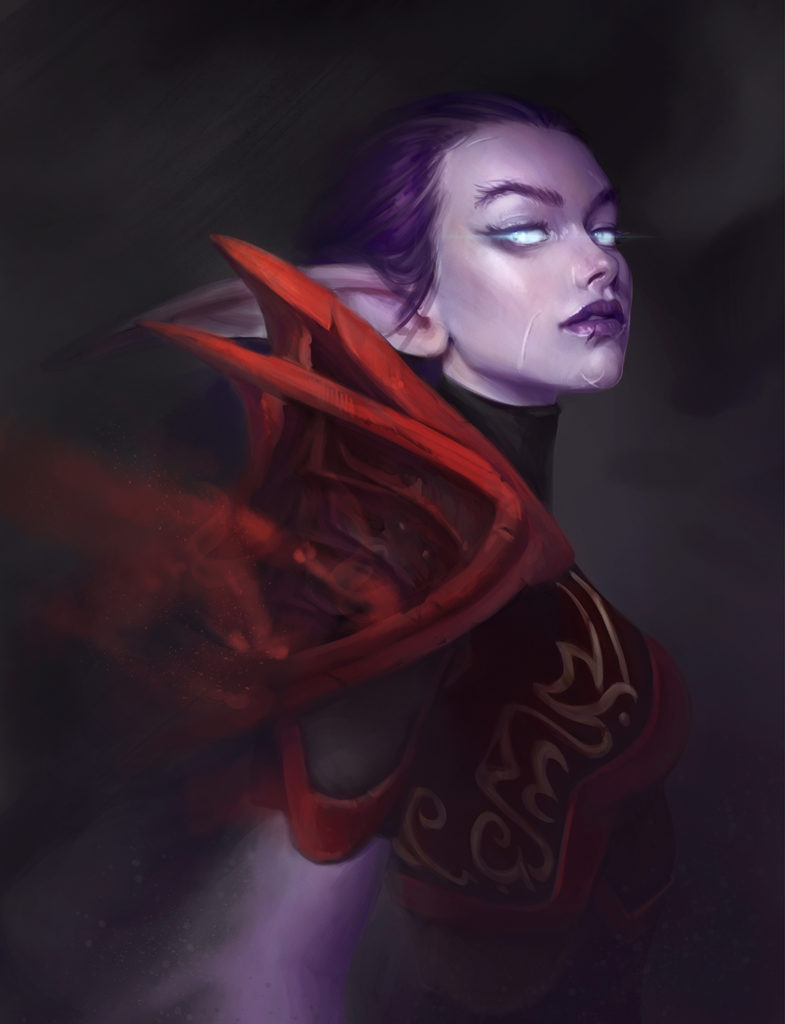
ENG | What artists or references do you think have influenced your style and way of working today?
World of Warcraft definitely had a big impact. My friend had a PC and internet and he let me play on his account, so I had been playing pretty much from 2004. However not anymore as I just don’t have the time and energy. Later other games played roles like Divinity 2 from Larian and Witcher 3 from CD Projekt Red.
I have many artists who inspire me in all different ways. Without any order; Marco Djurdjevic, Dave Greco, Mike Azevedo, Trent Kaniuga, Nesskain HKS, Craig Mullins, Marco Bucci, Nathan Fowkes and the list goes on and on. I think it is worth learning from these artists, they all have different and amazing styles but style is more like who you are than what you know professionally and on that level their knowledge is immensely valuable.
ESP | ¿Qué artistas o referencias crees que han influido en tu estilo y en tu forma de trabajar actual?
World of Warcraft tuvo sin duda un gran impacto. Mi amigo tenía un PC e Internet y me dejaba jugar con su cuenta, así que he estado jugando prácticamente desde 2004. Sin embargo, ya no, porque no tengo tiempo ni energía. Más tarde, otros juegos desempeñaron un papel importante, como Divinity 2 de Larian y Witcher 3 de CD Projekt Red.
Hay muchos artistas que me inspiran en todos los sentidos. Sin ningún orden; Marco Djurdjevic, Dave Greco, Mike Azevedo, Trent Kaniuga, Nesskain HKS, Craig Mullins, Marco Bucci, Nathan Fowkes y la lista sigue y sigue. Creo que vale la pena aprender de estos artistas, todos tienen estilos diferentes y sorprendentes, pero el estilo se parece más a lo que eres que a lo que sabes profesionalmente y en ese nivel sus conocimientos son inmensamente valiosos.
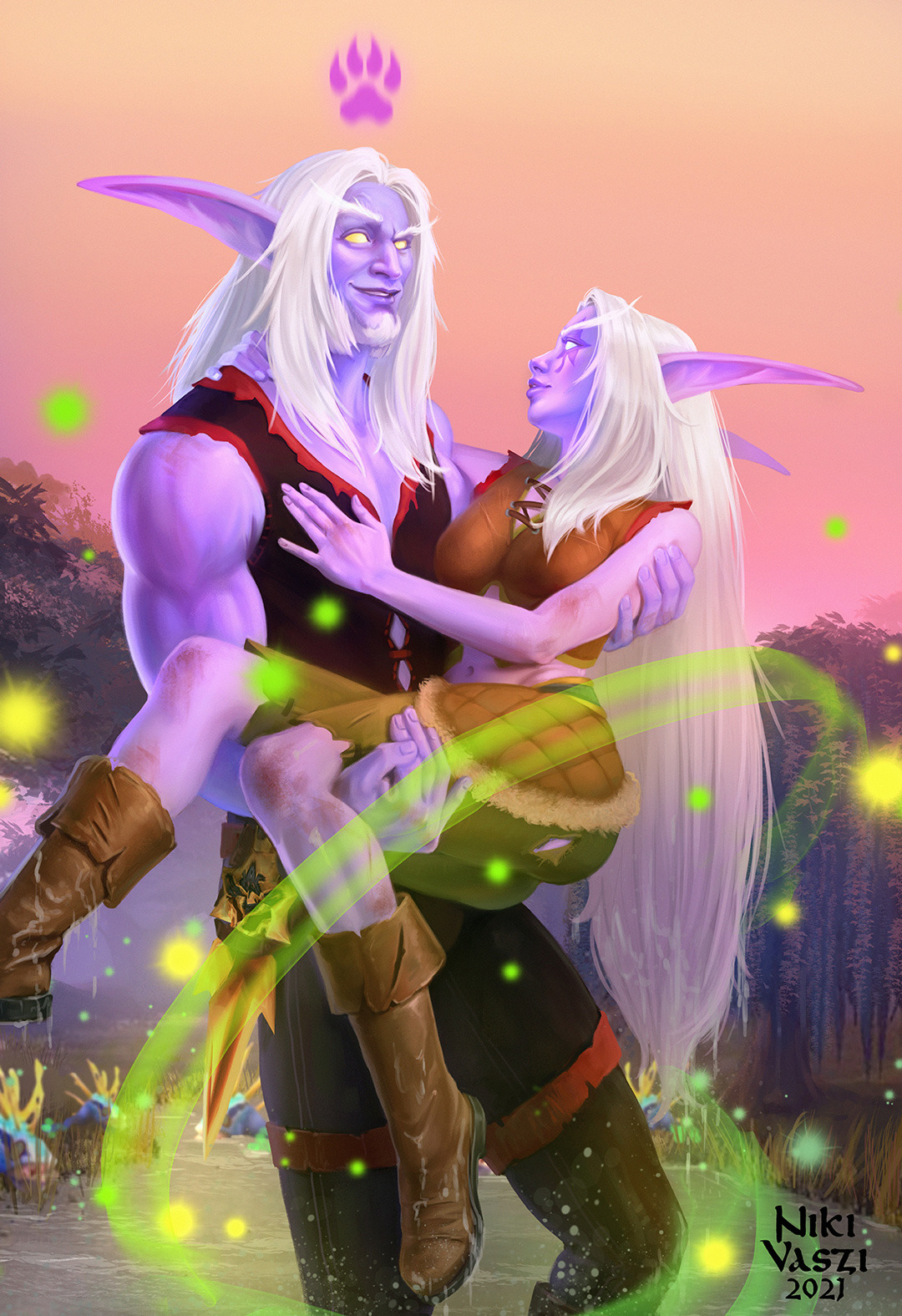
ENG | Now that we know you better, we want to highlight your great work for Gamelyn Games’ Tiny Epic series. What was the first game in the series that you illustrated and what did you learn from that project?
Tiny Epic Tactics, 2018. Michael Coe, CEO of Gamelyn Games has reached out to me with the project. He found my Little Heroes series, he liked them and he was curious if I was interested in creating a series of characters in that particular style. So I did a trial which went well, he was happy with the result and we started to work together.
The deadline was very tight so what I learned is how to work more efficiently but maintain quality. I created a method to handle the workload, make the deadline and give the best quality I could.
ESP | Ahora que te conocemos mejor, queremos destacar tu gran trabajo para la serie Tiny Epic de Gamelyn Games. ¿Cuál fue el primer juego de la serie que ilustraste y qué aprendiste de ese proyecto?
Tiny Epic Tactics, 2018. Michael Coe, director general de Gamelyn Games se puso en contacto conmigo con el proyecto. Encontró mi serie Little Heroes, le gustó y tenía curiosidad por saber si estaba interesado en crear una serie de personajes con ese estilo concreto. Así que hice una prueba que salió bien, él estaba contento con el resultado y empezamos a trabajar juntos.
El plazo era muy ajustado, así que lo que aprendí es a trabajar de forma más eficiente pero manteniendo la calidad. Creé un método para manejar la carga de trabajo, cumplir el plazo y dar la mejor calidad posible.
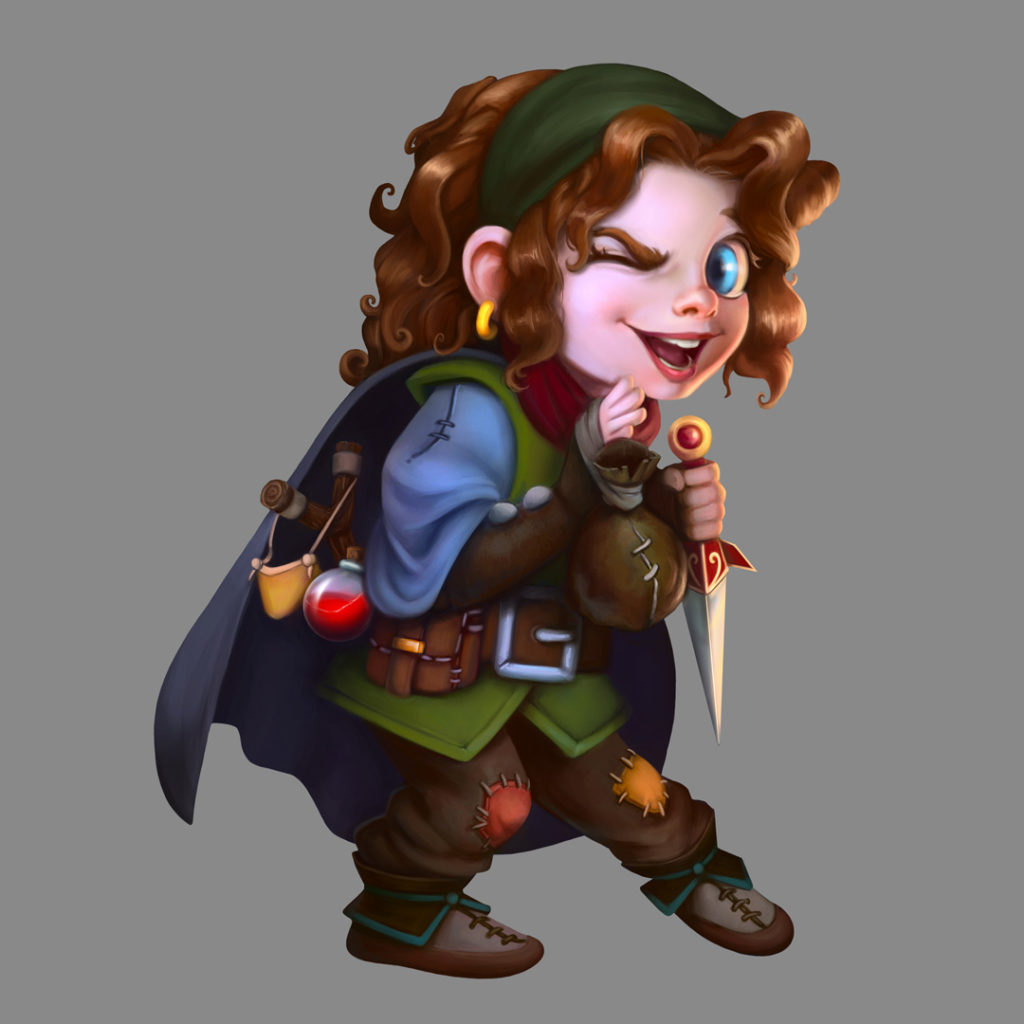
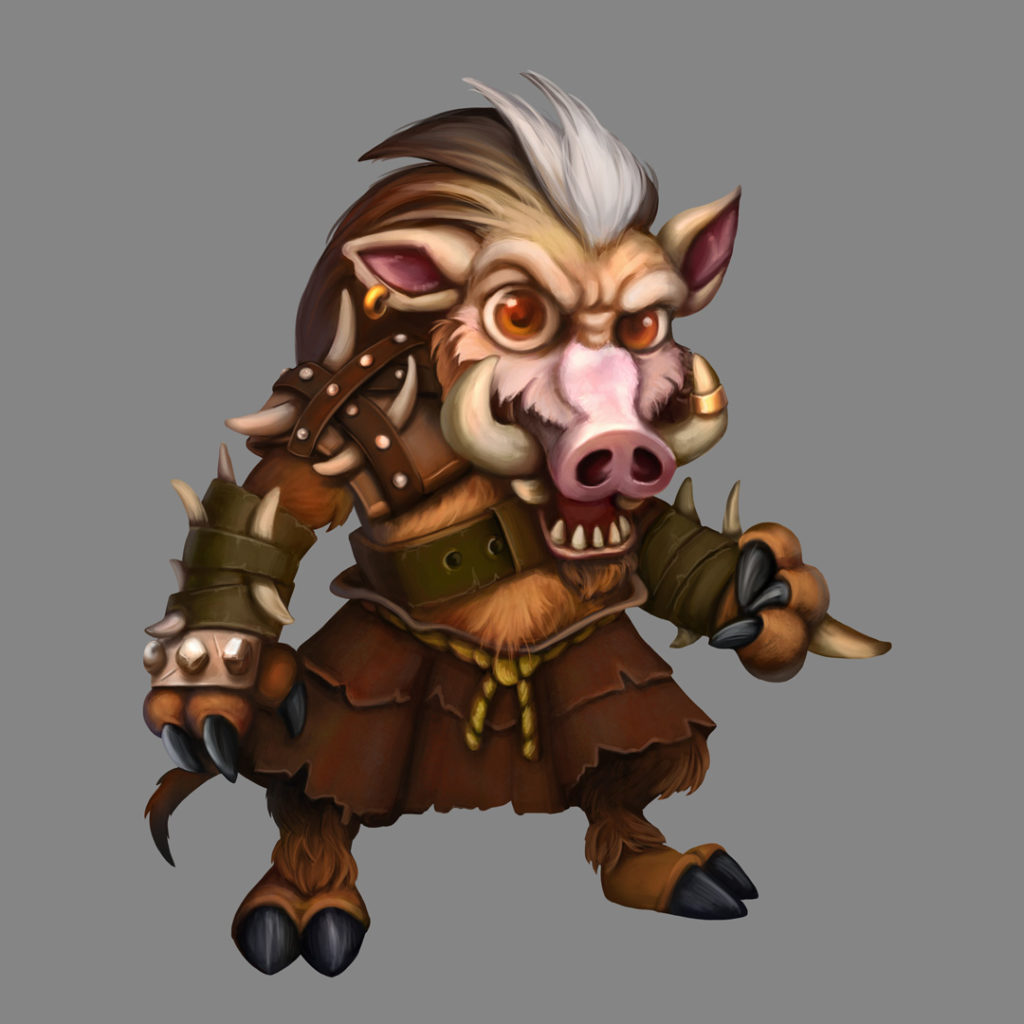
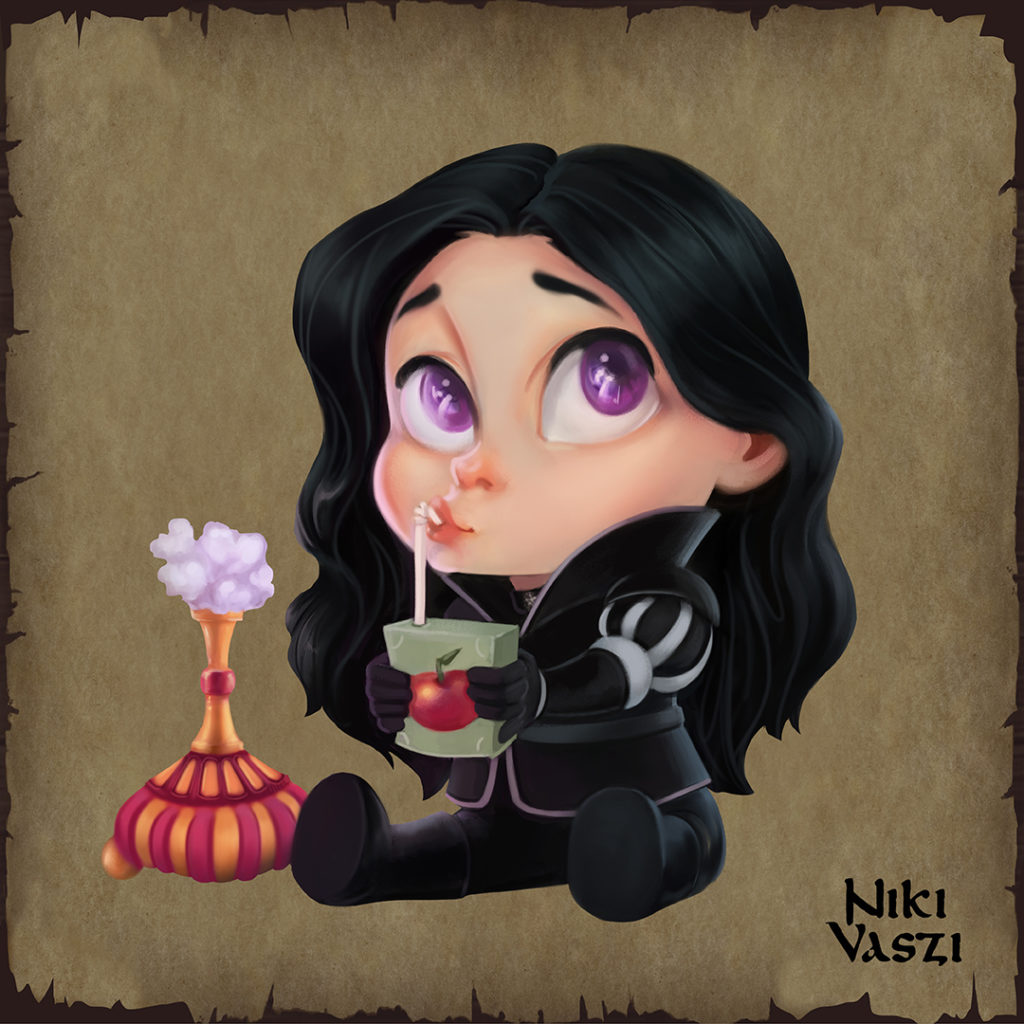
ENG | Of the entire series, in Tiny Epic Dinosaurs you did all the art for the game. Tell us how was your creation process and what challenges do you find in its elaboration?
My creation process usually looks like this: reading the brief several times, doing some research, gathering references, inspiration, studying the requested style, then organizing all these info so I can readily use them while I work. The first couple of artworks are the most challenging as we try to establish the overall look, I try to find the most suitable method to produce the illustrations. One of my trusty methods is working in black and white then after approval colorize them. I regularly send updates and request reviews throughout the project from concept phase to finals. I think good communication between client and artist is essential.
The biggest challenge was drawing dinos; up to that point I only drew a couple of times and now I had a whole project in my hand and they needed to look cute but still dangerous. I did studies and watched some dinosaur documentaries to get a nice grasp on the theme.
ESP | De toda la serie, en Tiny Epic Dinosaurs hiciste todo el arte del juego. ¿Cuéntanos cómo fue tu proceso de creación y qué retos encuentras en su elaboración?
Mi proceso de creación suele ser el siguiente: leer el briefing varias veces, investigar un poco, reunir referencias, inspiración, estudiar el estilo solicitado, y luego organizar toda esta información para poder utilizarla fácilmente mientras trabajo. Los primeros trabajos son los más difíciles, ya que se trata de establecer el aspecto general, y trato de encontrar el método más adecuado para producir las ilustraciones; uno de mis métodos de confianza es trabajar en blanco y negro y, tras la aprobación, colorearlas. Envío regularmente actualizaciones y solicito revisiones a lo largo de todo el proyecto, desde la fase de concepto hasta la final. Creo que una buena comunicación entre el cliente y el artista es esencial.
El mayor reto fue dibujar dinosaurios; hasta ese momento sólo había dibujado un par de veces y ahora tenía todo un proyecto en mis manos y tenían que parecer simpáticos pero a la vez peligrosos. Hice estudios y vi algunos documentales sobre dinosaurios para entender bien el tema.
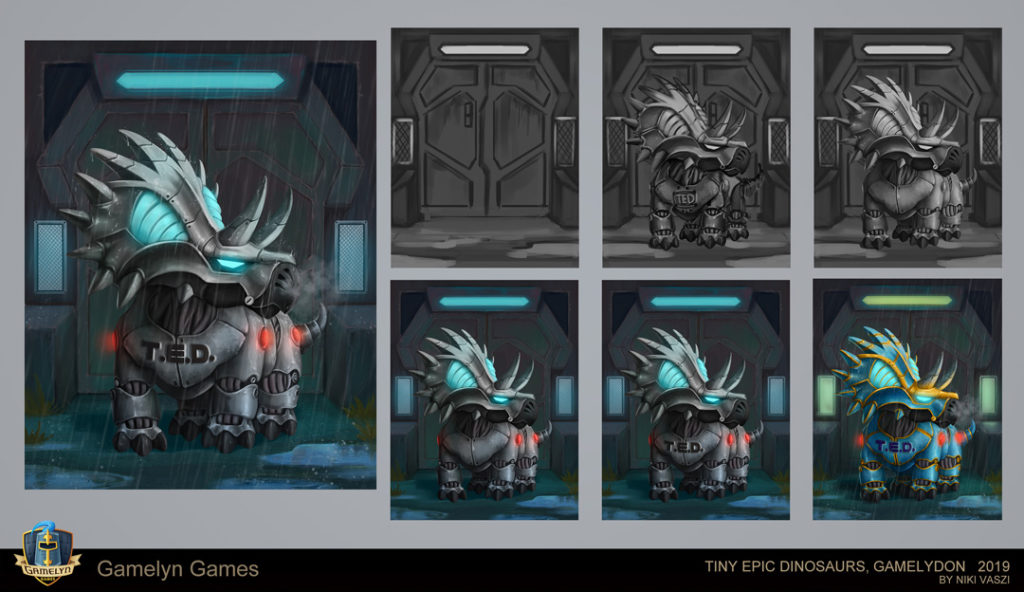
ENG | We have to confess that we LOVE the Allosaurus you created. What is your favorite dinosaur from Tiny Epic Dinosaurs?
Mosasaurus – I love sea creatures and a little silliness. I had fun painting the shark 🙂 Robot tricera, aka Gamelydon is awesome too – I really enjoyed creating him. I love the Fossil T Rex too. Okay I stop…soon I will list all of them for various reasons 😀
ESP | Tenemos que confesar que nos encanta el Allosaurus que has creado. ¿Cuál es tu dinosaurio favorito de Tiny Epic Dinosaurs?
Mosasaurus – Me encantan las criaturas marinas y un poco tontas. Me divertí pintando el tiburón 🙂 Robot tricera, alias Gamelydon es impresionante también – Realmente disfruté de la creación de él. También me encanta el Fossil T Rex. Vale ya paro…pronto haré una lista de todos ellos por diversas razones 😀
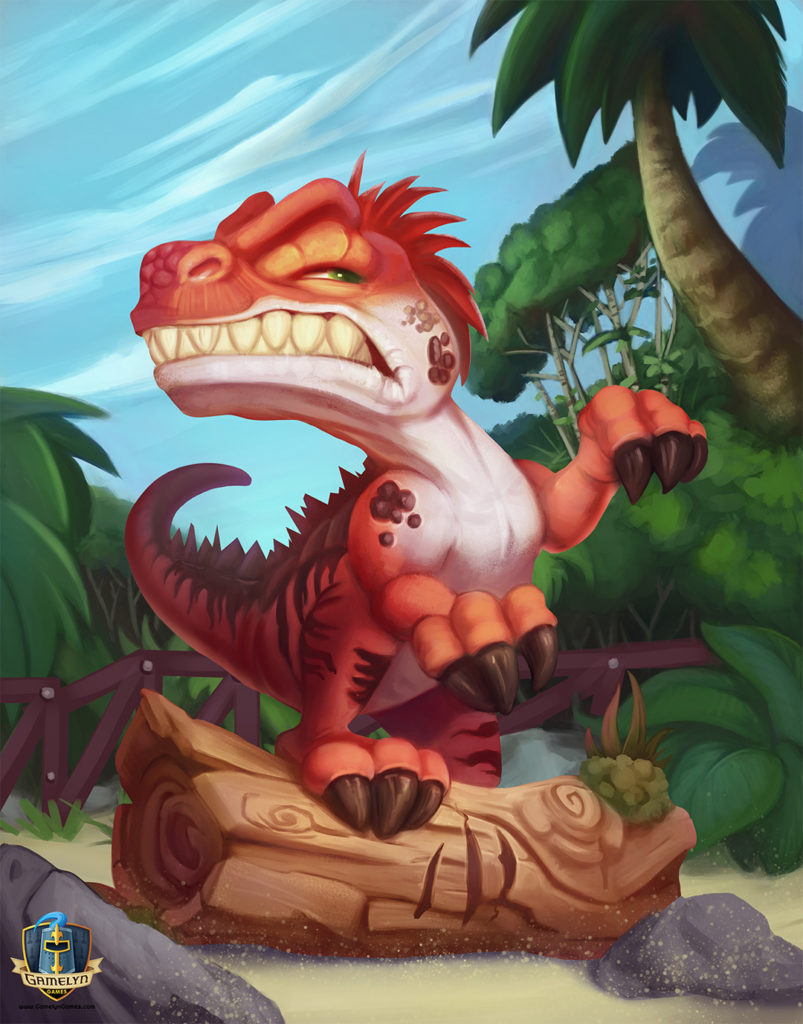
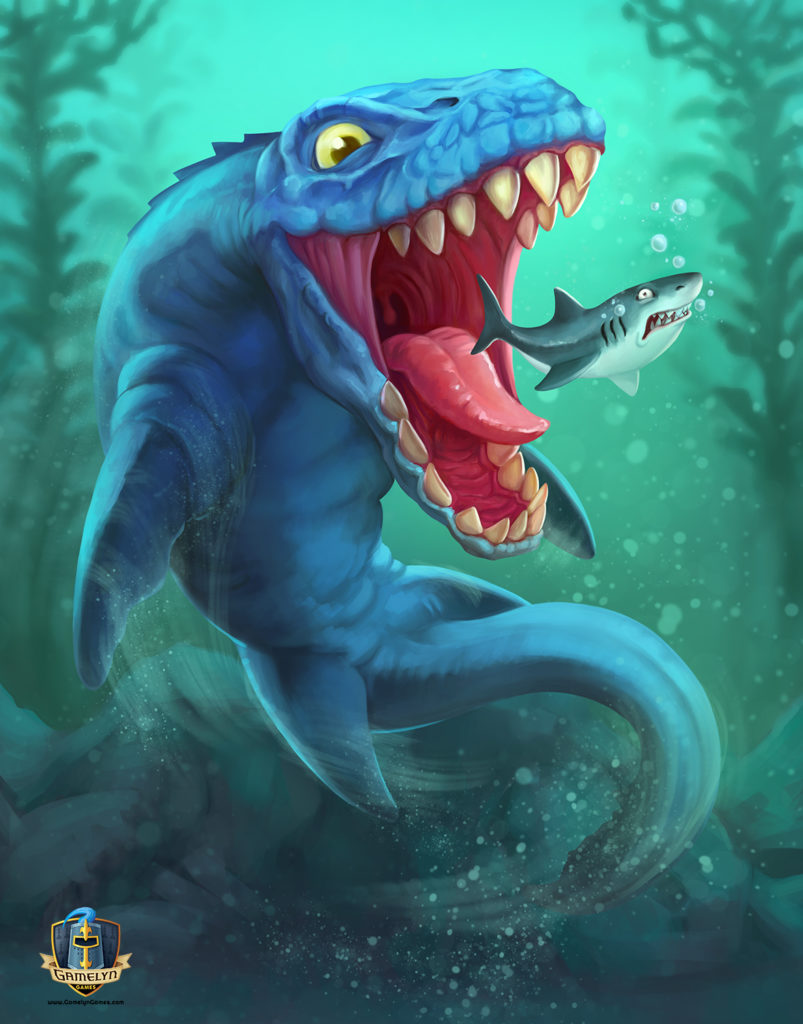
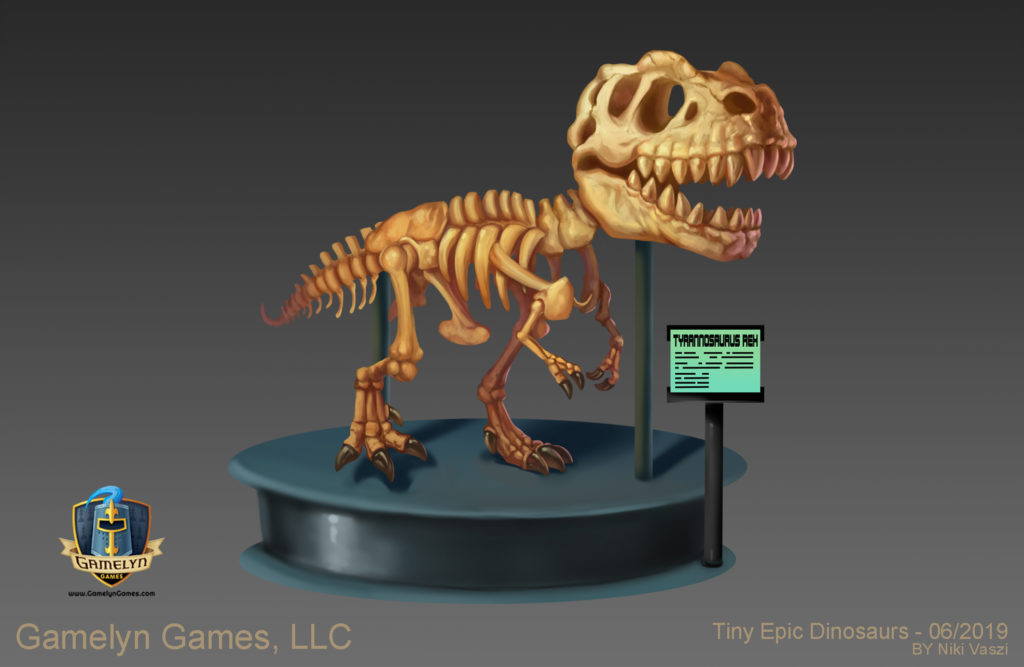
ENG | In Tiny Epic Tactics we can see a large number of characters. How was the documentation and creation process for all these units? Do they usually give you freedom when creating them?
Yes, 32 in total, plus monsters. I got the brief with the descriptions of the characters – some of them were very specific, I got reference pictures attached as well as they were well established characters in the Gamelyn universe, like Sir Gamelyn. I usually have creative freedom with some limits. It is not like I do whatever I want, it is more like I start concepting, sketching and this opens up the discussion of what would be the direction. It works as an anchor point. Michael is very open minded so presenting ideas is never an offence, at the same time he has a very strong vision about his projects – he knows what he wants. I am here to help those visions realize so we communicate every idea.
ESP | En Tiny Epic Tactics podemos ver un gran número de personajes. ¿Cómo fue el proceso de documentación y creación de todas estas unidades? ¿Suelen dar libertad a la hora de crearlos?
Sí, 32 en total, más los monstruos. Recibí el briefing con las descripciones de los personajes -algunos de ellos eran muy específicos, me adjuntaron imágenes de referencia además de que eran personajes bien establecidos en el universo Gamelyn, como Sir Gamelyn. Normalmente tengo libertad creativa con algunos límites. No es que haga lo que quiera, es más bien que empiezo a concebir, a esbozar y esto abre la discusión sobre cuál sería la dirección. Funciona como un punto de anclaje. Michael tiene una mentalidad muy abierta, por lo que presentar ideas nunca es una ofensa, pero al mismo tiempo tiene una visión muy fuerte sobre sus proyectos: sabe lo que quiere. Yo estoy aquí para ayudar a que esas visiones se hagan realidad, así que comunicamos todas las ideas.
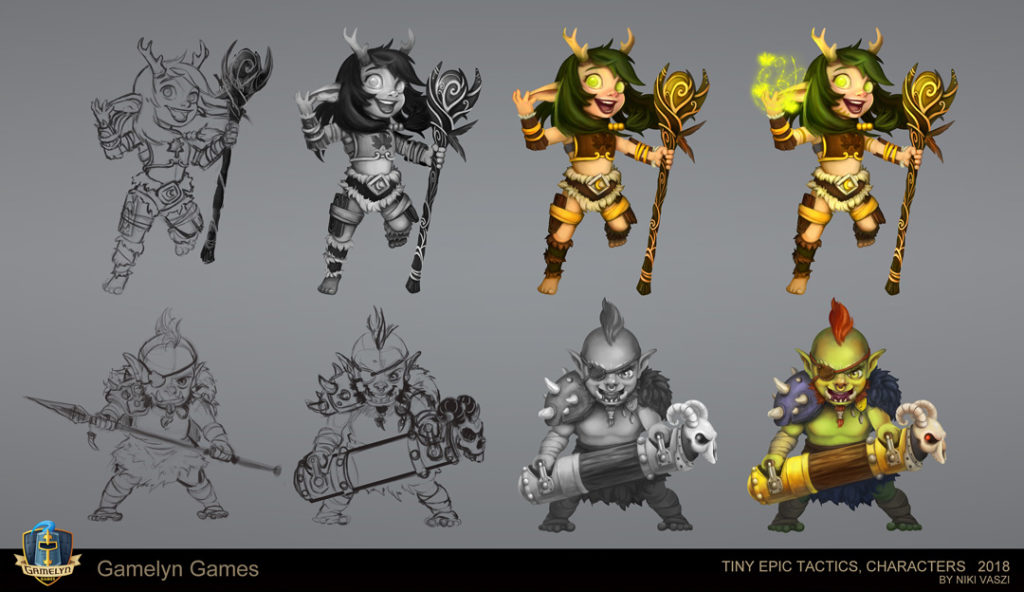
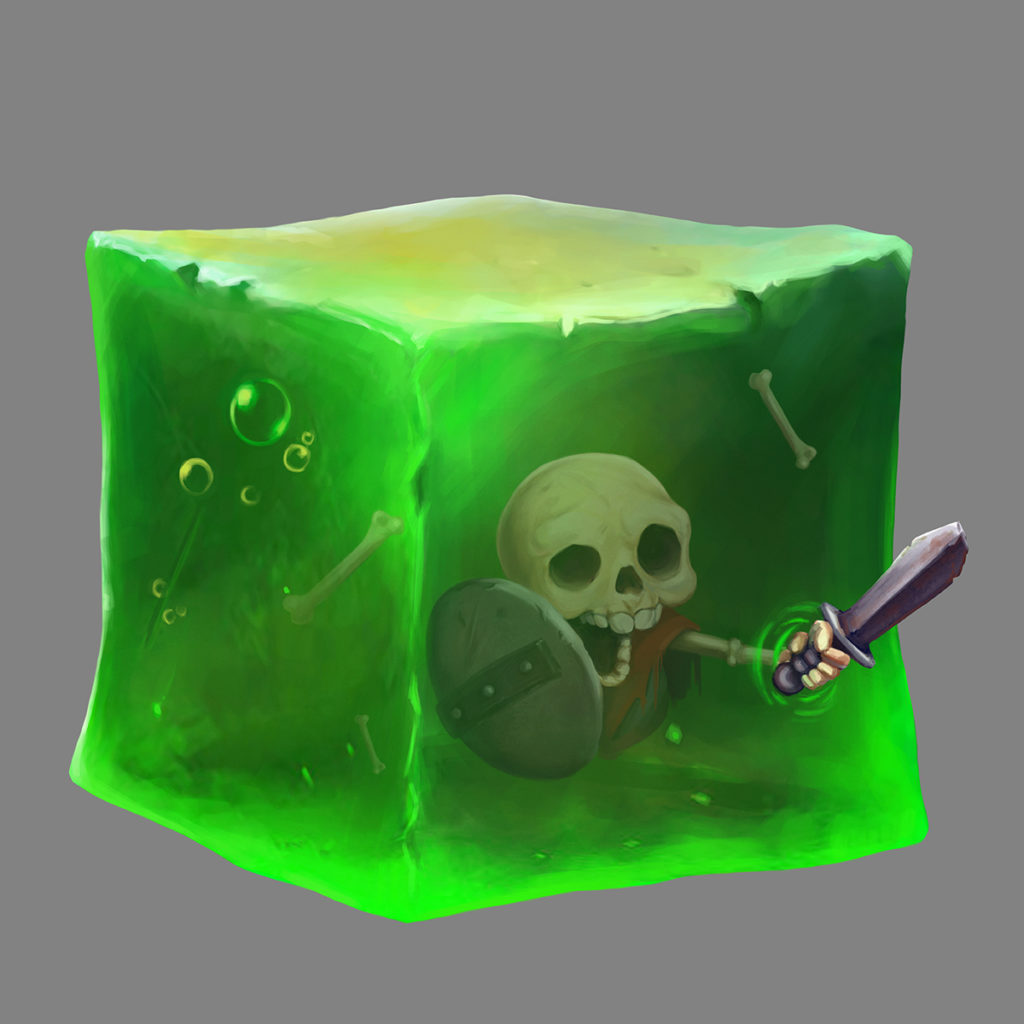
ENG | When you illustrate a card, the art and design must be adapted to have good readability, could you give our readers 3 tips that you consider key to illustrating cards for board games?
1) Make sure the illustration reads and works in black and white. You can set up a second window in Photoshop; Window>Arrange>New window for XY, then View>Proof set ups> Custom> Dot grain 20%. Or just pull a new layer on the top of everything, fill it with black and set the layer style in color.
2) Squinting or zooming out regularly. This helps to see if you can still tell what is on the card. If it reads as a big blob of mess, you have to work on the values more. It should look like a chess board – light on dark and dark on light. It takes a lot of time and practice to get a grip of this and I think I still need to learn a lot about values but this is a good starting point.
3) Good composition. Read the brief and know the purpose, the story. Highest contrast (value, shape, details, color and so on) should be at the focal point but to know where the focal point you need to know the story. Try to avoid over detailing and such as those can derail the whole picture. I am totally guilty to over rendering things and losing focal point; layers and undo button is my way to go back in time 😀 It is okay to make mistakes. What matters is the ability to recognize and correct them.
ESP | Cuando ilustras una carta, el arte y el diseño deben adaptarse para tener una buena legibilidad, ¿podrías dar a nuestros lectores 3 consejos que consideras clave para ilustrar cartas para juegos de mesa?
1) Asegúrate de que la ilustración se lee y funciona en blanco y negro. Puedes configurar una segunda ventana en Photoshop; Ventana>Rango>Nueva ventana para XY, y luego Ver>Configuración de la prueba> Personalizada> Grano de punto 20%. O simplemente tire una nueva capa en la parte superior de todo, llenarlo con negro y establecer el estilo de capa en color.
2) Entrecerrar los ojos o alejar el zoom regularmente. Esto ayuda a ver si todavía puedes leer lo que está en la carta. Si se lee como una gran mancha desordenada, tiene que trabajar más en los valores. Debería parecerse a un tablero de ajedrez: claro sobre oscuro y oscuro sobre claro. Se necesita mucho tiempo y práctica para dominar esto y creo que todavía tengo que aprender mucho sobre los valores, pero este es un buen punto de partida.
3) Buena composición. Leer el briefing y conocer el objetivo, la historia. El mayor contraste (valor, forma, detalles, color, etc.) debe estar en el punto focal, pero para saber dónde está el punto focal hay que conocer la historia. Intenta evitar el exceso de detalles y demás, ya que pueden desbaratar el conjunto de la imagen. Yo soy totalmente culpable de sobredimensionar las cosas y perder el punto focal; las capas y el botón de deshacer son mi forma de volver atrás en el tiempo 😀 Está bien cometer errores. Lo que importa es la capacidad de reconocerlos y corregirlos.

ENG | For Tiny Epic Pirates we can see a change in their art, being more realistic and adult. Is that the type of (more realistic) art you feel most comfortable with?
Tiny Epic Tactics and Dinosaurs’ style is not everyones cup of tea. There is the bad association that cartoony, stylized art is for kids only. I think this is false, I think it is good to have different types of style, why so serious all the time? I think the audience got used to realistic styles too much with the advanced technology. Movies, video games become hyper realistic, played out front of green screens, motion capture recording method, everything is 3D. I think the whole purpose of art is expression and diversity.
Now every movie, every game looks the same. I recently just had a chance to watch Arcane, the League of Legends story series and it blew my mind as an artist. Perfect combination of utilizing modern technology but having a unique artistic expression. I think Gamelyn is doing the right thing to allow as many styles as possible and dedicate whole projects for a particular style. Keep in mind art is subjective so I am not saying one style is good or bad, I am saying any style can be fun.
When it comes to my style I am pretty much a chameleon. It is not rare that the first half of my day I work in a stylized style and in the second half in a more realistic or painterly one. I tell you it can be exhausting and the biggest downfall of this is I am jack of all trades but master of none. I got used to this and it pushes me out of my comfort zone, forces me to learn, improve and adapt. I learned to love the creating process, the style at this point is not really a matter.
ESP | En el caso de Tiny Epic Pirates podemos ver un cambio en su estilo, siendo más realista y adulto. ¿Es ese tipo de estilo (más realista) es con el que te sientes más cómoda?
El estilo de Tiny Epic Tactics and Dinosaurs no es del agrado de todos. Existe la mala asociación de que el arte caricaturesco y estilizado es sólo para niños. Creo que esto es falso, creo que es bueno tener diferentes tipos de estilo, ¿por qué tan serio todo el tiempo? Creo que el público se ha acostumbrado demasiado a los estilos realistas con la tecnología avanzada. Las películas y los videojuegos se han vuelto hiperrealistas, se representan delante de pantallas verdes, con el método de grabación de captura de movimiento, todo es 3D. Creo que el objetivo del arte es la expresión y la diversidad.
Ahora todas las películas, todos los juegos parecen iguales. Hace poco tuve la oportunidad de ver Arcane, la serie de historias de League of Legends, y me dejó boquiabierto como artista. Es una combinación perfecta de utilización de la tecnología moderna, pero con una expresión artística única. Creo que Gamelyn está haciendo lo correcto al permitir tantos estilos como sea posible y dedicar proyectos enteros a un estilo particular. Hay que tener en cuenta que el arte es subjetivo, así que no estoy diciendo que un estilo sea bueno o malo, sino que cualquier estilo puede ser divertido.
En lo que respecta a mi estilo, soy bastante camaleónico. No es raro que la primera mitad del día trabaje en un estilo estilizado y en la segunda mitad en uno más realista o pictórico. Te digo que puede ser agotador y que la mayor desventaja de esto es que soy un experto en todo pero a la vez en nada. Me acostumbré a esto y me empuja a salir de mi zona de confort, me obliga a aprender, mejorar y adaptarme. Aprendí a amar el proceso de creación, el estilo en este momento no es realmente una cuestión.
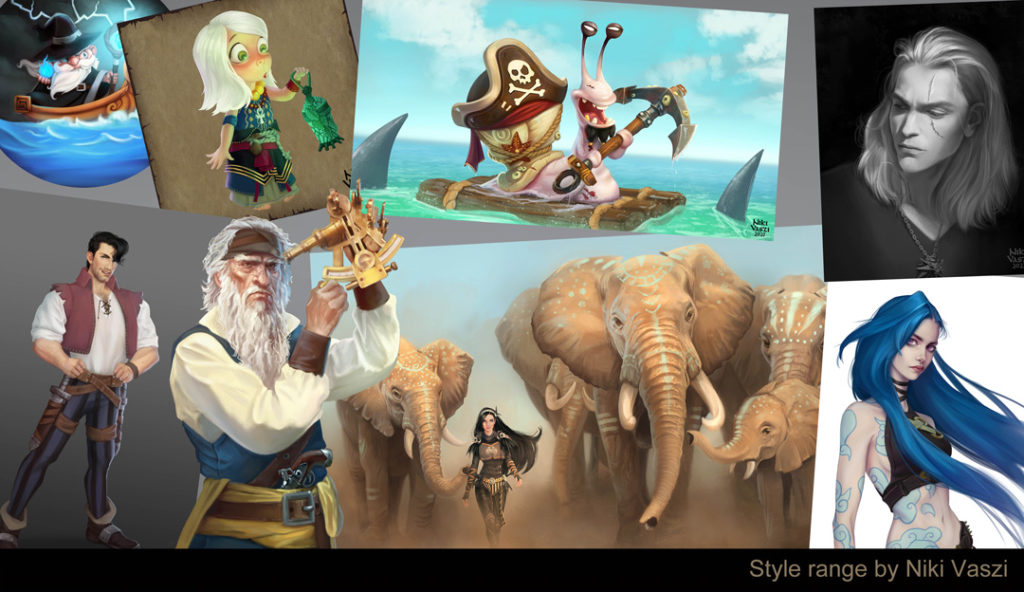
ENG | Tell us about your creation process and what challenges have you encountered in making Tiny Epic Pirates?
My creation process is always tailored to the actual project. Starting in grayscale then colorizing it, or starting with lineart, flat colors then adding the shadows and lights layer by layer, or freestyle – just start to paint under a loose sketch and combination of these.
The biggest challenge was that most of the artwork was already done but Michael needed some extra artworks ASAP. I had to try to mimic Felix Wermke’s style which is a bit different from work in a general artstyle, or work with someone from the beginning, collaborating. Plus my workstation has just died on me. Tight deadline, struggling to adapt that style and working on a backup laptop with only 8GB ram.
But as they say:
Smooth seas don’t make good sailors.
ESP | ¿Háblenos de su proceso de creación y de los retos que ha encontrado al hacer Tiny Epic Pirates?
Mi proceso de creación siempre se adapta al proyecto en cuestión. Comienzo en escala de grises y luego lo coloreo, o empiezo con lineart, colores planos y luego añado las sombras y las luces capa a capa, o estilo libre -simplemente empiezo a pintar bajo un boceto suelto y una combinación de estos.
El mayor reto era que la mayor parte de las ilustraciones ya estaban hechas, pero Michael necesitaba algunas ilustraciones adicionales cuanto antes. Tuve que intentar imitar el estilo de Felix Wermke, que es un poco diferente de trabajar en un estilo artístico general, o trabajar con alguien desde el principio, colaborando. Además, mi equipo de trabajo acababa de morir. Un plazo ajustado, luchando por adaptar ese estilo y trabajando en un portátil de reserva con sólo 8GB de ram.
Pero como dicen:
Los mares tranquilos no hacen buenos marineros.
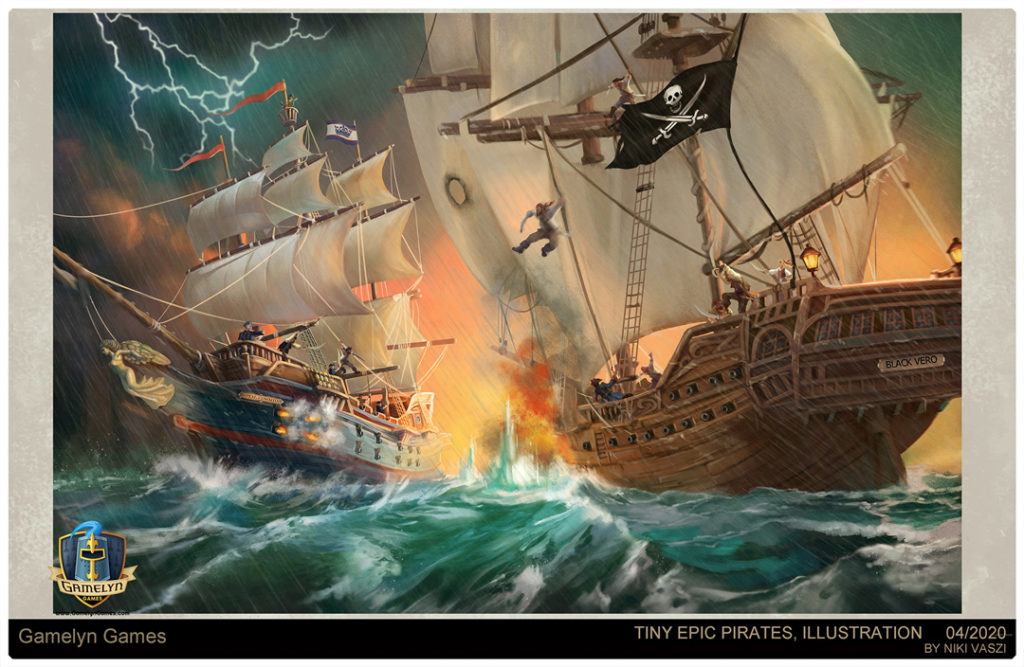
ENG | Finally, one of your last works for the series is the Tiny Epic Dungeon, where we can see a wide variety of objects and weapons, what are the challenges to keep these elements interesting and attractive?
Know the story of those objects/subjects and explore it. Ask questions, like what do you associate with panthers? You know they are cats, they have dark colors, nocturnals, they are sneaky, mysterious, dangerous, they have sharp claws but at the same time they ooze elegance. You know you will use blacks, purples or blues, and silvery colors, dark tones, also sharp edges but with twists and swirls here and there to add elegance. If you know the story you can tell it.
ESP | Por último, uno de tus últimos trabajos para la serie es el Tiny Epic Dungeon, donde podemos ver una gran variedad de objetos y armas, ¿cuáles son los retos para mantener estos elementos interesantes y atractivos?
Conocer la historia de esos objetos/sujetos y explorarla. Haz preguntas, como ¿qué asocias con las panteras? Sabes que son gatos, que tienen colores oscuros, que son nocturnos, que son escurridizos, misteriosos, peligrosos, que tienen garras afiladas pero que al mismo tiempo rezuman elegancia. Sabes que usarás negros, morados o azules, y colores plateados, tonos oscuros, también bordes afilados pero con giros y remolinos aquí y allá para añadir elegancia. Si conoces la historia puedes contarla.
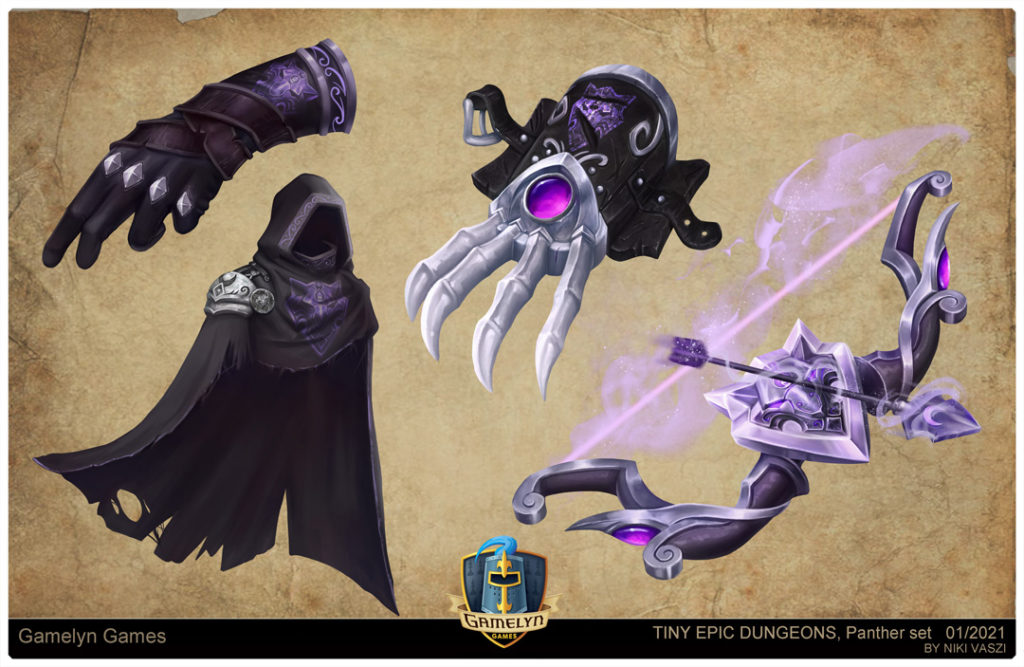
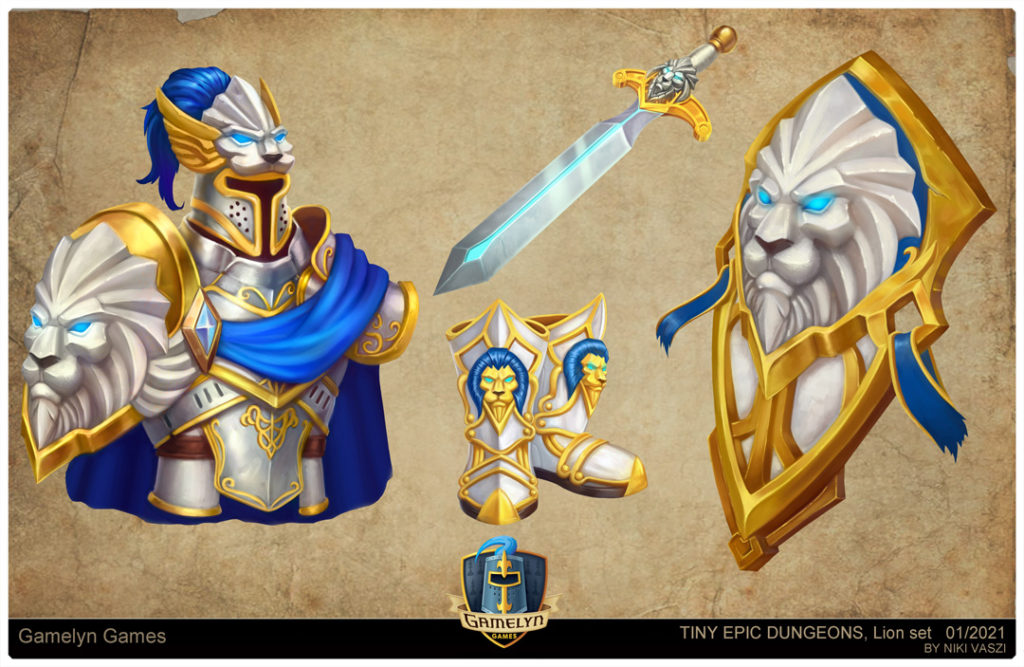
ENG | Finally, what projects are you currently working on?
On a professional level it is top secret, but on a personal level I can share some info. Currently whenever I have an extra hour or so free I learn Blender and develop my IP. The story builds around a druid, Neeko Northwind and is about her and her friends adventures. It is a big world building project with story, so I am designing characters, environments, society structure, plots and many more. I have a good friend who helps out with story writing as he is an expert in that. This is my play time nowadays.
ESP | Por último, ¿en qué proyectos está trabajando actualmente?
A nivel profesional es alto secreto, pero a nivel personal puedo compartir alguna información. Actualmente, cada vez que tengo una hora libre más o menos, aprendo Blender y desarrollo mi IP. La historia gira en torno a una druida, Neeko Northwind, y trata de sus aventuras y las de sus amigos. Es un gran proyecto de construcción de un mundo con historia, así que estoy diseñando personajes, entornos, estructura de la sociedad, tramas y muchas cosas más. Tengo un buen amigo que me ayuda a escribir la historia, ya que es un experto en ello. Este es mi tiempo de juego hoy en día.
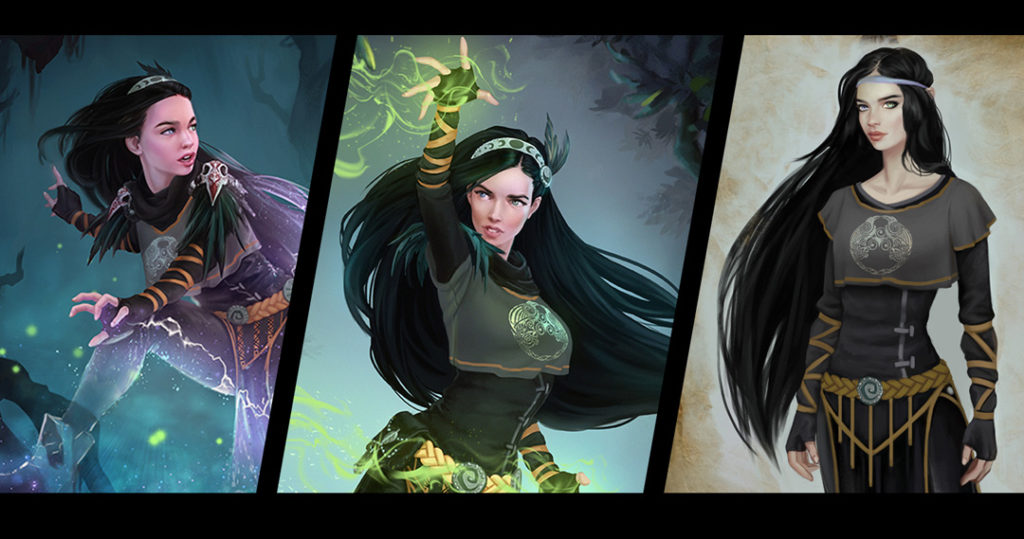
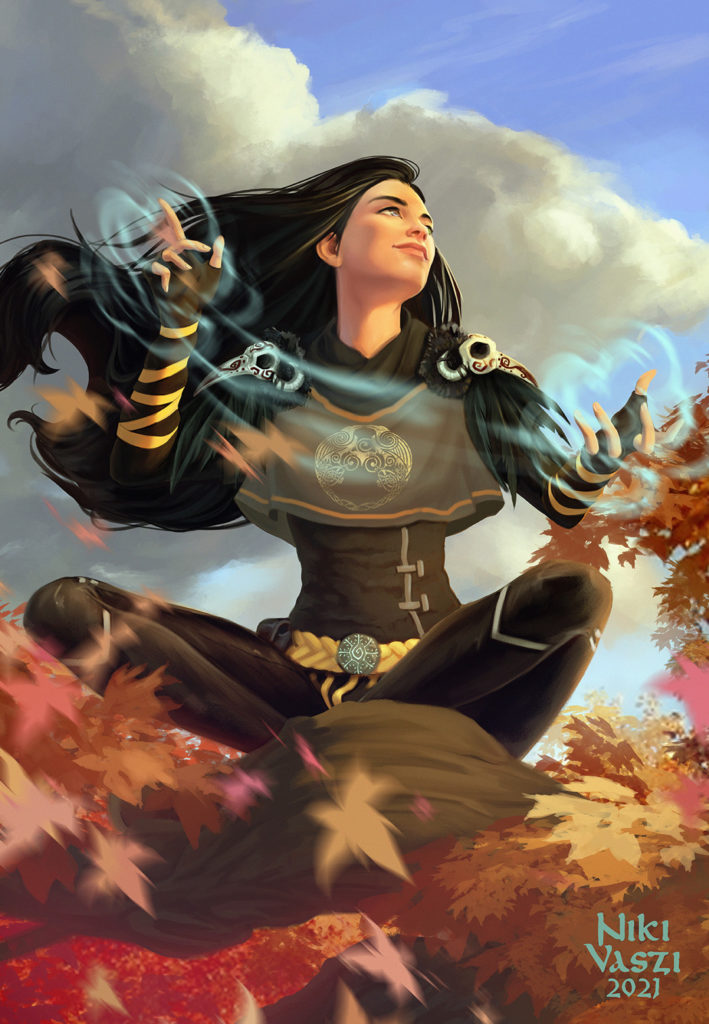
Muchas gracias Niki 😉
(Todas las imágenes cedidas por Nikoletta Vaszi)

